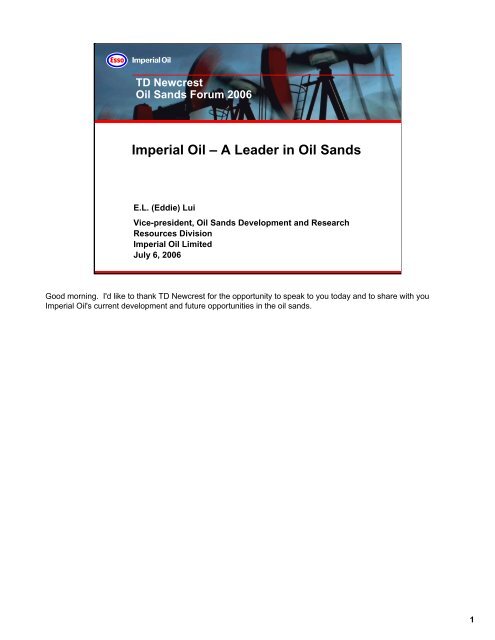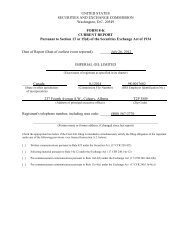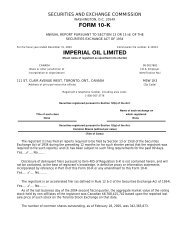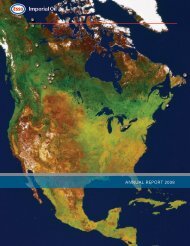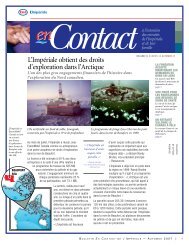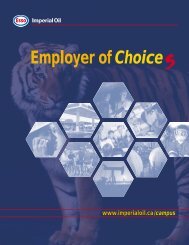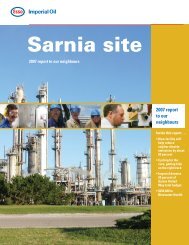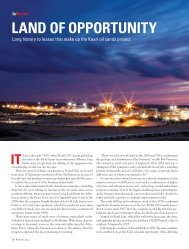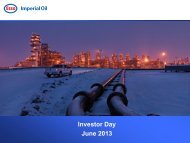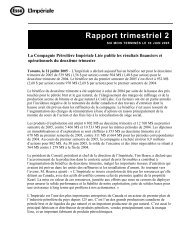(Eddie) Lui, Remarks by EL (Eddie) Lui, vice-president ... - Imperial Oil
(Eddie) Lui, Remarks by EL (Eddie) Lui, vice-president ... - Imperial Oil
(Eddie) Lui, Remarks by EL (Eddie) Lui, vice-president ... - Imperial Oil
Create successful ePaper yourself
Turn your PDF publications into a flip-book with our unique Google optimized e-Paper software.
Raymond<br />
TD Newcrest<br />
James <strong>Oil</strong> Sands of Canada Conference<br />
<strong>Oil</strong> Sands Forum 2006<br />
<strong>Imperial</strong> <strong>Oil</strong> – A Leader in <strong>Oil</strong> Sands<br />
E.L. (<strong>Eddie</strong>) <strong>Lui</strong><br />
Vice-<strong>president</strong>, <strong>Oil</strong> Sands Development and Research<br />
Resources Division<br />
<strong>Imperial</strong> <strong>Oil</strong> Limited<br />
July 6, 2006<br />
Slide 1<br />
Good morning. I'd like to thank TD Newcrest for the opportunity to speak to you today and to share with you<br />
<strong>Imperial</strong> <strong>Oil</strong>'s current development and future opportunities in the oil sands.<br />
1
Cautionary Statement<br />
This presentation contains forward-looking information on<br />
future production, project start-ups and future capital spending.<br />
Actual results could differ materially due to changes in project<br />
schedules, operating performance, demand for oil and gas,<br />
commercial negotiations or other technical and economic<br />
factors.<br />
<strong>Oil</strong>-equivalent barrels (OEB) may be misleading, particularly if<br />
used in isolation. An OEB conversion ratio of 6,000 cubic feet<br />
to one barrel is based on an energy-equivalency conversion<br />
method primarily applicable at the burner tip and does not<br />
represent a value equivalency at the well head.<br />
Slide 2<br />
Before we begin, I want to remind you that the presentation this morning contains forward-looking information and<br />
actual results could be different as a result of many factors -- which are noted on this slide.<br />
2
Significant <strong>Oil</strong> Sands Position<br />
• Active in the oil sands<br />
since early 1960s<br />
• Premier lease position<br />
and quality resource<br />
Current oil sands production<br />
<strong>Oil</strong> Sands<br />
Land Holdings<br />
(K acres, net)<br />
<strong>Oil</strong> Sands<br />
Non-proved<br />
Resource (GB)<br />
In situ 361 3<br />
Mining 104 7<br />
Total 465 10<br />
Undeveloped oil sands lease locations<br />
Slide 3<br />
<strong>Imperial</strong>'s oil-sands assets are enormous in size and scope, and offer long-term growth opportunities for the<br />
company.<br />
We have been a pioneer in the development of Canada's vast oil-sands resources since the early 60's -- in both<br />
in-situ and mining projects.<br />
This map illustrates the three major oil-sands deposits and shows our position in both current oil-sands production<br />
(red symbols) and in undeveloped oil-sands leases (gold symbols).<br />
<strong>Imperial</strong> holds about 465,000 acres of oil-sands leases including Cold Lake -- the largest in-situ oil-sands<br />
operation in the world and the premier in-situ project in Canada. This asset is wholly owned and operated <strong>by</strong><br />
<strong>Imperial</strong>.<br />
<strong>Imperial</strong> also has extensive oil-sands interests which are currently undeveloped -- mostly in the Athabasca area of<br />
Alberta. The gold star northeast of Fort McMurray represents the Kearl leases on which we propose to develop a<br />
300,000 barrel-a-day mining project with ExxonMobil Canada.<br />
The gold star to the southeast of Fort McMurray represents a number of leases which we are evaluating for<br />
development using in-situ methods.<br />
Let me start with a few words on our development at Cold Lake with some history on our research efforts in the oil<br />
sands.<br />
3
Cold Lake – Technology in Action<br />
1966<br />
1978<br />
1982<br />
1985<br />
1990<br />
1995<br />
2000<br />
2005<br />
Pilots<br />
CSS<br />
patent<br />
Produced<br />
water<br />
recycling<br />
SAGD<br />
patent<br />
Commercial<br />
project<br />
start-up<br />
3-D seismic<br />
steam<br />
analysis<br />
Passive<br />
seismic<br />
monitoring<br />
Infill<br />
recovery<br />
processes<br />
Liquid addition<br />
recovery<br />
patent<br />
Solvent<br />
recovery<br />
processes<br />
Ideas<br />
Enhanced Recovery Pilot<br />
Alternate Recovery Technique<br />
• Enhanced recovery pilot in<br />
operation since 2002<br />
• Commercial development<br />
2006/07<br />
• AEUB application filed<br />
for pilot<br />
Slide 4<br />
<strong>Imperial</strong> has been a leader in the development of much of the technology that has underpinned the commercial<br />
development of Canada's vast oil-sands resource.<br />
The circles at the top of this chart highlight the numerous technology advances that we have made at Cold Lake<br />
since the 1960's. <strong>Imperial</strong> invested over $250 million on research and technology development before the start-up<br />
of the Cold Lake commercial project in 1985. Many of you may not know that <strong>Imperial</strong> invented and held patents<br />
on both cyclic steam stimulation (CSS) and steam assisted gravity drainage (SAGD).<br />
Our ongoing commitment to technology is unwavering. Our most recent success is a process we successfully<br />
patented in 2005. This invention enhances CSS performance through the addition of diluent with the steam. As a<br />
result, we will increase recovery in areas already developed, using existing wells, facilities and infrastructure. We<br />
have piloted this process since 2002 and an application will be filed with the AEUB for a larger-scale<br />
implementation of the technology later this quarter, with field start-up occurring in 2007.<br />
In June we filed a pilot application with the AEUB for another recovery process. This new recovery process<br />
(shown in the schematic on the lower right) enhances the performance of SAGD through the addition of diluent<br />
with the steam. Drilling of two well pairs required for the pilot is to occur in early 2007, once the pilot application<br />
has been approved <strong>by</strong> the AEUB.<br />
This sustained commitment to development of technology is a unique competitive advantage for <strong>Imperial</strong> <strong>Oil</strong>.<br />
4
Cold Lake – A Premier In Situ Asset<br />
200<br />
Bitumen (KBPD)<br />
180<br />
160<br />
140<br />
120<br />
100<br />
80<br />
Recovery Factor<br />
Average Production<br />
Growth 1992-2005<br />
4% per year<br />
13% 17% 25% 30 + %<br />
Phases<br />
1-6<br />
Phases<br />
7-10<br />
Phases<br />
11-13<br />
60<br />
40<br />
20<br />
Pilot<br />
Production<br />
0<br />
1965 1975 1985 1995 2005<br />
Slide 5<br />
<strong>Imperial</strong>'s wholly-owned Cold Lake project is a world-class asset and the premier in-situ asset in the oil sands. It<br />
produces as much as all other thermal in-situ oil-sands projects combined.<br />
As you can see from the graph on this slide, bitumen production at Cold Lake has increased significantly since our<br />
first pilots in the 1960s, to the current production level of over 150,000 barrels-per-day. We have taken a deliberate,<br />
phased approach to developing this high-quality asset -- bringing production on in stages to incorporate advances in<br />
technology into new production phases.<br />
Across the top of the graph in red, I have listed the changes in bitumen recovery factor over the last 20 years. The<br />
increase from 13% to 30+% is a direct result of our continued focus in research and technology development and our<br />
growing expertise in thermal operations.<br />
5
Cold Lake – Current Development<br />
Near term development focused on northern extension<br />
Cold Lake Lease Area<br />
Under<br />
Evaluation<br />
Developed Area<br />
Northern Extension<br />
Plants<br />
Approved Development Area<br />
Mineral Lease<br />
• New generation of facilities –<br />
advantage of phased approach<br />
• Modified pad “custom-fit”<br />
• IOL-patented completion<br />
technique<br />
“MegaPad” Concept<br />
8 Horizontal wells<br />
220 m<br />
~700-1000 m<br />
16 vertical wells<br />
Footprint of standard<br />
Cold Lake Pad<br />
7 Equivalent bottom hole locations<br />
Slide 6<br />
Looking forward ...<br />
Near term development at Cold Lake is focused on developing the "northern extension" of our approved<br />
development area.<br />
The Cold Lake lease area (shown as the dashed black line on the map) is about 300 square miles. The approved<br />
development area shown as the solid black line is about 140 square miles and we are currently active in about half<br />
of that.<br />
Our efforts to the end of the decade are to develop the area shown in red, one of the new areas which we received<br />
regulatory approval for in 2004. Over the next five years, we plan to develop 10 new pads in this area. The first<br />
investments were made in 2005 with the drilling of two new pads in the southerly part of this area -- we are just<br />
completing construction of the surface facilities and will begin steaming these pads in the next few months.<br />
This development is another example of our commitment to continuous improvement through application of new<br />
technology at Cold Lake;<br />
• The well design and layout in this development has been customized to optimize resource access.<br />
• Looking at the illustration in the bottom right of this slide, you can see that these new 'mega' pads use<br />
horizontal as well as vertical wells. One pad can now access the same resource as three standard Cold<br />
Lake pads, which reduces the overall capital required for this development, as well as the surface<br />
footprint.<br />
• For successful thermal operations, it is essential to control the steam distribution in a horizontal well to<br />
achieve optimal production results. <strong>Imperial</strong> has developed a patented completion technique with a<br />
special designed wellbore assembly to achieve this objective.<br />
Finally, I'll draw your attention to the black rectangle directly to the east of our northern extension area. This is the<br />
next section of the Cold Lake lease that we will develop. We have a team in place evaluating the most economic<br />
options to bring this part of the Cold Lake lease into production.<br />
6
Syncrude<br />
A long-life, high quality mining resource<br />
KBD<br />
100<br />
80<br />
60<br />
40<br />
IMO 25% Share<br />
• <strong>Imperial</strong> an original owner<br />
• Recent expansion project<br />
increases production 40%<br />
• Early May start-up affected<br />
<strong>by</strong> de-sulphurization unit<br />
20<br />
1979<br />
2005 2007<br />
Slide 7<br />
Turning to mining....<br />
<strong>Imperial</strong> is a founding member of the Syncrude consortium established in 1964 and remains the operation's<br />
second-largest owner, holding a 25 percent interest.<br />
Syncrude is the largest oil-sands operation in the world, with a resource base to support decades of production.<br />
Annual production from Syncrude has steadily increased since its start-up 25 years ago.<br />
The recently completed Stage 3 expansion included the addition of a third, 100,000 barrel-a-day coker. As a<br />
result, site production will ultimately increase <strong>by</strong> about 40 percent. As well, the quality of the entire synthetic<br />
crude output will be improved to capture higher realizations.<br />
The expansion project was completed and started up on May 6, but unfortunately had to be brought down on May<br />
18 to deal with a persistent odour problem associated the start-up of the new Flue Gas Desulphurization unit.<br />
Syncrude has been working with experts from ExxonMobil to resolve this unexpected problem, and the current<br />
expectation is that the underlying problem will be rectified and the new coker brought back on line later this month.<br />
7
Kearl <strong>Oil</strong> Sands Project<br />
• Proposed 300 KBD mining project<br />
NE of Fort McMurray<br />
• <strong>Imperial</strong> <strong>Oil</strong> (70%) and ExxonMobil<br />
Canada (30%)<br />
• <strong>Imperial</strong> is project operator<br />
• Progress to date:<br />
– conceptual engineering and process<br />
selection completed<br />
– regulatory application filed July 2005<br />
– joint provincial/federal panel<br />
expected to begin hearings in fall<br />
Slide 8<br />
Let me turn now to Kearl, a proposed bitumen mining project in Fort McMurray.<br />
<strong>Imperial</strong> owns a roughly 70 percent interest and is operator of the project. The remaining 30 percent is held <strong>by</strong><br />
ExxonMobil Canada.<br />
The Kearl leases hold sufficient bitumen to support a 300,000 barrel-a-day mine for more than 40 years. We plan<br />
to develop the Kearl project in phases with the initial phase sized at 100,000 barrels-per-day, and two subsequent<br />
phases to follow.<br />
To date, we have completed conceptual engineering and process selection for the project.<br />
The regulatory application was filed in July 2005. We were notified last month that a joint provincial/federal panel<br />
will conduct the hearings for the Kearl project, and we expect public hearings to begin this fall with a regulatory<br />
decision about the end of this year.<br />
8
Resource (MB Bitumen)<br />
Kearl – “Bigger and Better” is Best<br />
<strong>Imperial</strong> participates in top-tier mining projects<br />
5,000<br />
4,500<br />
4,000<br />
3,500<br />
3,000<br />
2,500<br />
2,000<br />
1,500<br />
1,000<br />
500<br />
Syncrude<br />
Aurora North<br />
<strong>Imperial</strong> <strong>Oil</strong><br />
Kearl<br />
Syncrude<br />
Aurora South<br />
Less Material Handling<br />
0<br />
6 7 8 9 10 11 12 13 14<br />
Industry/Proposed<br />
Projects<br />
Average Total Volume to Bitumen In Place (TV:BIP)<br />
Slide 9<br />
Kearl is arguably the best undeveloped resource in the Athabasca region -- and with apologies to our<br />
conference host, while "bigger is better" in some circles, for Kearl, a bigger resource combined with a better<br />
quality is best for development.<br />
This chart plots projects based on the relative size and quality of the bitumen resource.<br />
The "x" axis plots "TV to BIP" (total volume to bitumen in place) -- a key quality metric for mineable oil sands.<br />
This measures the total volume that has to be mined -- overburden plus ore -- relative to the amount of<br />
bitumen-in-place. Low numbers are better. Less material is handled for each barrel of bitumen produced, so<br />
there is a natural operating expense advantage for a mine.<br />
The "y" axis plots recoverable resource. The "sweet spot" on this graph is the upper left hand corner indicating<br />
high quality and large recoverable resource.<br />
The red circles represent industry projects -- both producing and proposed. The blue symbols represent the<br />
projects that <strong>Imperial</strong> is participating in -- you can see that Syncrude and Kearl are both high quality projects<br />
and Kearl is the best of the bunch.<br />
For the entire Kearl mine -- all three phases -- TV to BIP is 7.8. The combination of the high quality of the Kearl<br />
resource on the site and large resource size -- 4.6 billion barrels -- is a significant economic advantage for<br />
development of this project.<br />
I'd like to add that although the current mine plan filed in our regulatory application for Kearl is 4.6 billion<br />
barrels of recoverable bitumen, total bitumen-in-place on the Kearl leases is over 13 billion barrels.<br />
9
Additional Heavy Crude Capacity<br />
Capacity expansions in key markets<br />
KBD Heavy Crude Equivalent<br />
6,000<br />
5,000<br />
4,000<br />
3,000<br />
2,000<br />
1,000<br />
0<br />
North American Refining<br />
Coking Capacity<br />
PADD II PADD IV PADD III PADD V Canada<br />
2005 10 Year 2% Creep<br />
Incremental/”creep” investments<br />
Potential upgrader projects<br />
• >7.5 MBD coking<br />
capacity in target<br />
markets<br />
• Additional incremental<br />
coking expected; +1.7<br />
MBD <strong>by</strong> 2015 in US<br />
markets<br />
• Potential for +~2 MBD<br />
for proposed Canadian<br />
upgrading projects<br />
Source: Actual <strong>Oil</strong> & Gas Journal; Projections IOL<br />
Slide 10<br />
A final point on Kearl related to how we will market the bitumen.....<br />
For the first phase of Kearl, we plan to market the bitumen as a blended heavy or sour crude, selling into the<br />
increasingly expanding North American markets for Canadian heavies. Marketing plans for volumes from additional<br />
phases are being developed.<br />
Our assessment is that the most economic approach for the first 100,000 barrels-per-day phase of Kearl bitumen is<br />
to market to existing upgrading facilities.<br />
<strong>Imperial</strong> refineries already process a significant amount of heavy crude oil and we will advance low-cost expansions<br />
to take more. But, more broadly, we expect that there will be additional heavy crude capacity in the markets we<br />
currently sell into.<br />
For capital-intensive industries, the most attractive investment is incremental expansion, or "creep" -- and this is<br />
especially true for the refining business.<br />
The blue bars on this chart illustrate current coking capacity, expressed in thousands of barrels of Heavy Crude<br />
Equivalent - over 7.5 million barrels per day in the North American market.<br />
Modest creep shown in the blue hatched bar of only two percent a year will yield an additional 1.7 million barrels per<br />
day of capacity <strong>by</strong> 2015. In addition, there are proposed upgrading projects in Canada, shown in the red checkered<br />
bar -- either stand-alone or with dedicated bitumen supply -- that could deliver an additional two million barrels per<br />
day of capacity <strong>by</strong> 2015.<br />
We'll continue to evaluate upgrading facilities at our Edmonton refinery. But a decision to do so will not be made<br />
until we're convinced that this capital investment will be profitable, competitive and yield attractive returns for our<br />
shareholders.<br />
10
<strong>Oil</strong> Sands Production Outlook<br />
Success case doubles oil sands production <strong>by</strong> 2015<br />
Slide 11<br />
This chart illustrates the potential impact of <strong>Imperial</strong>'s oil sands resource portfolio on future production. The<br />
successful development of the Kearl resource along with continued selective investments at Syncrude and Cold<br />
Lake, could lead to doubling of <strong>Imperial</strong>'s production from the oil sands <strong>by</strong> 2015.<br />
11
A Leader in Canada’s <strong>Oil</strong> Sands<br />
• Pioneer in the development of Canada’s oil sands<br />
• Leader in oil sands research<br />
• Significant current position – potential for future growth<br />
- Cold Lake<br />
- Syncrude expansion projects<br />
- Kearl mining project<br />
- Undeveloped oil sands assets<br />
Slide 12<br />
Let me close with a summary of the key points that I feel distinguish <strong>Imperial</strong> <strong>Oil</strong> as a leader in the development of<br />
oil sands.<br />
We have been a pioneer in the development of oil sands -- with extensive operating experience and knowledge.<br />
Our continued commitment to research and technology development will provide us with the key to continued<br />
economic and responsible development of oil-sands resources.<br />
We hold a significant position in the oil sands resource -- with high-quality assets like Cold Lake -- and are well<br />
positioned for continued future growth in both in-situ operations as well as mining.<br />
Thank you for your attention.<br />
12
For more information<br />
<strong>Imperial</strong> <strong>Oil</strong> Limited’s site on the World Wide Web contains a variety<br />
of corporate and investor information. It can be accessed at<br />
http://www.imperialoil.ca.<br />
For more detailed investor information, or to receive annual and<br />
interim reports, please contact:<br />
Susan Swan<br />
Manager, Investor Relations<br />
<strong>Imperial</strong> <strong>Oil</strong> Limited<br />
237 Fourth Avenue SW<br />
Calgary, Alberta T2P 3M9<br />
Email: susan.b.swan@esso.ca<br />
Phone: (403) 237-4537<br />
Slide 13<br />
13


